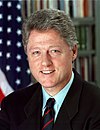|
19th G7 summit
The 19th G7 Summit was held in Tokyo, Japan, on July 7–9, 1993. The venue for the summit meetings was the State Guesthouse in Tokyo, Japan.[2] The Group of Seven (G7) was an unofficial forum which brought together the heads of the richest industrialized countries: France, Germany, Italy, Japan, the United Kingdom, the United States, Canada (since 1976),[3] and the President of the European Commission (starting officially in 1981).[4] The summits were not meant to be linked formally with wider international institutions; and in fact, a mild rebellion against the stiff formality of other international meetings was a part of the genesis of cooperation between France's president Valéry Giscard d'Estaing and West Germany's chancellor Helmut Schmidt as they conceived the first Group of Six (G6) summit in 1975.[5] Leaders at the summit The G7 is an unofficial annual forum for the leaders of Canada, the European Commission, France, Germany, Italy, Japan, the United Kingdom and the United States.[4] The 19th G7 summit was the first summit for US President Bill Clinton and the last summit for Japanese Prime Minister Kiichi Miyazawa. It was also the first and only summit for Canadian Prime Minister Kim Campbell and Italian Prime Minister Carlo Azeglio Ciampi. Participants These summit participants are the current "core members" of the international forum:[6][2][7]
IssuesThe summit was intended as a venue for resolving differences among its members. As a practical matter, the summit was also conceived as an opportunity for its members to give each other mutual encouragement in the face of difficult economic decisions.[5] Issues which were discussed at this summit included:
AccomplishmentsIn 1993, the summit leaders called for an "international agreement" to "protect forests," but there is little evidence of follow-up action.[8] Gallery of participating leadersCore G7 participantsSee alsoNotes
References
External links
|
||||||||||||||||||||||||||||||||||||||||||||||||||||||
Portal di Ensiklopedia Dunia











